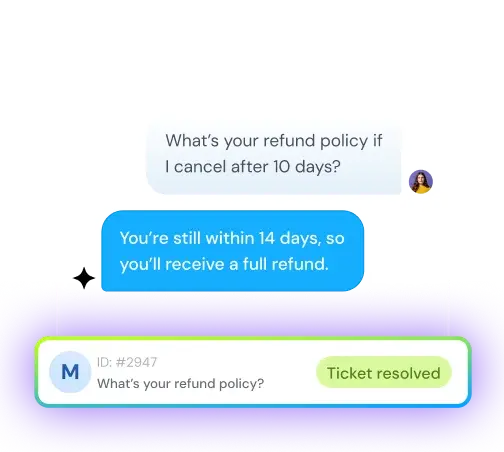What most founders get wrong about startup customer service (and how to fix it)
Sneha Arunachalam
May 27, 2025
-900x600.webp)
Ask any customer why they left a startup, and the answer usually isn’t the product — it’s the service.
Founders are busy juggling product launches, growth targets, funding rounds, and endless Slack pings. So when a support ticket comes in? It’s either buried in a shared inbox or passed around like a hot potato.
But here’s the truth no one likes to say out loud:
Startup customer service can make or break your business.
It’s not just about answering questions — it’s about building trust, fueling retention, and setting the tone for your brand. In fact, 96% of customers say great service creates brand loyalty, yet most startups still struggle to get it right.
The upside? Customers do come back if you meet their needs — and the fastest-growing companies know it. Startups on the path to unicorn status implement self-service options 61% more often than their peers. Meanwhile, nearly half of startup leaders are actively looking for better service options due to rising support costs and unanswered tickets.
In this piece, we’ll dig into:
- The biggest customer service mistakes startups make
- Simple ways to train your team and build smart systems
- How to measure what matters
- And how to support the humans behind your support
Because these aren’t just customer service tweaks — they’re growth levers that separate thriving startups from those that stall out.
The most common startup customer service mistakes (and how to Avoid Them)
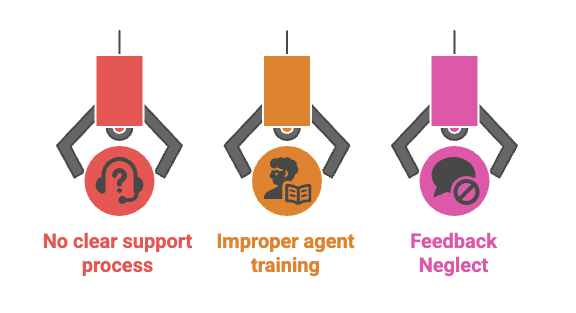
When you're a startup, it’s easy to get laser-focused on building your product and chasing growth. But while you’re busy shipping features and pitching investors, customer service often gets left behind — and that’s where things start to crack.
Here are the biggest mistakes most startups make when it comes to customer support — and what to do instead.
1. No clear support process
Let’s start with the most common culprit: no defined process for handling customer issues.
In the early days, it’s tempting to just “figure it out as you go.” But without a clear system, support tasks get dropped, delayed, or tossed between team members like hot potatoes.
This creates two types of bottlenecks in startup customer service:
- Short-term bottlenecks during sudden spikes in volume (like after a launch or big PR hit)
- Long-term bottlenecks caused by deeper process issues that never got fixed
Want to know if this is happening to you? Watch for:
- Support wait times getting longer than your team promised
- A growing backlog of unanswered tickets
- Agents constantly scrambling just to keep up
At some point, email alone won’t cut it. Shared inboxes might work for a handful of tickets a day — but once your user base grows, they collapse under the pressure. Urgent messages get lost, follow-ups are forgotten, and your customer history? Scattered across threads and spreadsheets.
If you’re scaling, it’s time to move beyond email and set up a proper ticketing system — one that grows with you and keeps everyone accountable.
2. Undertrained (or overwhelmed) agents
Another common startup trap: treating support like a reactive task instead of a skilled role.
Support agents are the frontline of your brand — but if they’re not trained properly, they can’t deliver the kind of experience your customers expect. And yet, in many startups, training is seen as a “nice to have,” not a priority.
That’s a mistake.
Poor training leads to:
- Inconsistent responses
- Longer resolution times
- Frustrated customers (and stressed-out team members)
It’s not just about knowing the product — it’s about communication, empathy, and knowing how to troubleshoot under pressure. Plus, when your agents are dealing with outdated tools and unrealistic expectations from managers who don’t understand their day-to-day, burnout happens fast.
Great startup customer service starts with great people — and great people need proper support, training, and tools to succeed.
3. Ignoring customer feedback
Here’s a dangerous myth: “We know our customers so well, we don’t need formal feedback.”
Wrong.
Whether it’s product bugs, feature requests, or complaints about the onboarding flow, your customers are telling you what matters — you just have to listen.
Some startups collect feedback but don’t analyze it. Others don’t collect it at all. Either way, the result is the same:
- You miss critical opportunities to improve
- You waste time building features no one asked for
- You slowly erode trust with your customers
Even worse? 56% of unhappy customers don’t even complain — they just leave.
So if you're only reacting to what you hear, you're missing a much bigger problem underneath the surface.
Startups that win at customer service have tight feedback loops. They use feedback to fix what’s broken, double down on what’s working, and show users they’re actually listening.
Because let’s be real — one bad experience is all it takes for a customer to leave. But when you handle feedback the right way? You turn problems into opportunities and create fans for life.
Train your team to handle real customer needs (not just scripts)
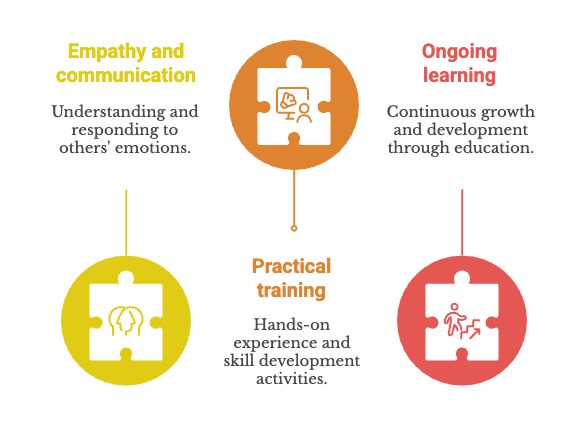
Great startup customer service isn’t just about fast replies — it’s about real human connection. And the startups that get this right? They invest early in training their teams to actually understand and help their customers, not just follow a script.
In fact, more than 20% of U.S. employers — including companies like LinkedIn and Tesla — now offer formal empathy training. Why? Because it works. Empathy-first support leads to higher customer satisfaction, stronger loyalty, and a brand that people actually trust.
Here’s how to build that kind of team from the ground up.
1. Start with empathy and communication
At the heart of every great support experience is empathy. Your team needs to be able to step into the customer’s shoes — not just solve the problem, but understand the frustration behind it.
A useful framework? The "Elements of empathy wheel", which includes:
- Reading tone and body language (even in text!)
- Listening fully, without jumping to respond
- Relating to the customer’s context
- Connecting emotionally (but professionally)
- Responding with care and clarity
To put this into practice, teach your team active listening skills. For example:
- Ask thoughtful questions to dig deeper into the issue
- Acknowledge emotions with phrases like “I totally get why that’s frustrating”
- Paraphrase what the customer said to show understanding
- Stay patient — don’t interrupt or rush to close the ticket
These small shifts in communication can turn a stressful interaction into a moment of loyalty.
2. Make training real (not theoretical)
Support training shouldn’t live in a PowerPoint deck. It should be real, relevant, and hands-on.
Role-playing real customer situations is one of the best ways to prep your team. Whether it’s a billing issue, a delayed delivery, or a bug that caused a headache — use real examples from your own support history.
Try this:
- Pair team members and assign actual past tickets to act out
- Let them swap roles — one plays the customer, the other plays the agent
- Debrief after each role-play to share feedback and best approaches
One fast-growing e-commerce startup completely overhauled its training by asking agents to reflect on similar moments they had as customers. This shift in perspective helped them approach interactions with more compassion and creativity.
The result? Fewer escalations, faster resolutions, and happier customers.
3. Make learning ongoing (not one-and-done)
Customer expectations evolve fast — and so should your team.
If you want to keep your startup customer service sharp, treat training as a continuous process, not a one-time event. Build a culture of curiosity where team members actively seek new skills, tools, and techniques.
Some high-impact ways to do this:
- Peer training: Let team members shadow each other or share tips during weekly syncs. Everyone has a strength — whether it’s calming angry customers or multitasking under pressure.
- Refresher sessions: Run short monthly workshops to revisit tricky scenarios and share updated best practices.
- Feedback loops: Use insights from real customer reviews and CSAT surveys to improve training content over time.
Bonus? Empathy training doesn’t just help customers — it also boosts morale. When agents feel empowered and supported, they deliver better service and are more likely to stick around.
Because in the end, startup customer service is only as good as the people delivering it. And when you invest in your team, your customers feel it.
Build startup customer service that actually works — and grows with you
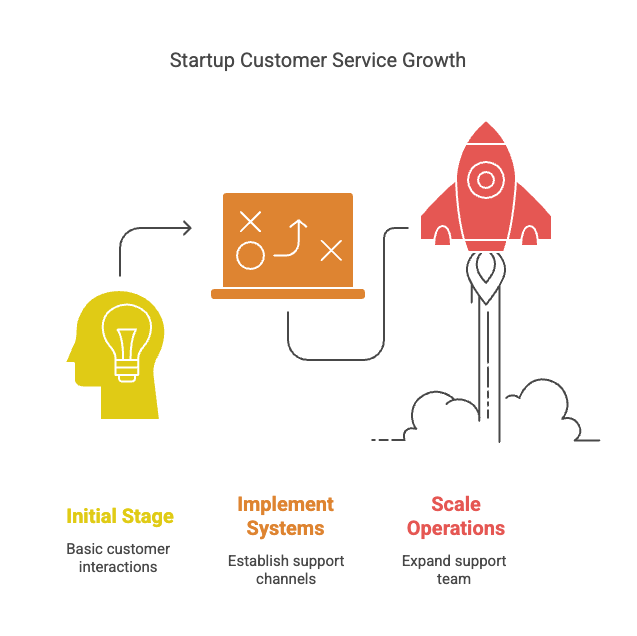
If you’re serious about startup customer service, you probably know that juggling support with spreadsheets or random inboxes is a nightmare. What you really need is a smart, simple system that pulls all your customer messages together and helps your team respond quickly and personally.
We’re not talking about just any tool here — this is about having a customer service management platform that grows as you do, giving you one clear place to see what customers need, no matter the channel.
Why having a good support platform matters for startups
Think of your customer service platform as the heart of your support operation. It gathers all the chats, emails, social messages — everything — and lays it out so your team can jump in without missing a beat.
Startups who switch to a proper system see some solid wins:
- Happier customers (we’re talking 42% better satisfaction)
- More people sticking around longer (41% higher retention)
- Teams saving hours every week by ditching busywork
Here’s the secret sauce:
- You break down data silos and keep all customer info in one spot
- You automate the boring stuff like ticket assignments and follow-ups
- You actually know your customers so you can help them better, faster
- You build processes that work every time — even when your team grows
And if you’re just getting started, don’t worry — the right platform sets you up to deliver great service from day one, even if you don’t have a big support team yet.
Picking the right support system for Your startup
Not every tool fits every startup — a five-person SaaS team won’t need the same setup as a growing eCommerce brand. So here’s what you want to look for:
- Easy-to-use ticket tracking that doesn’t feel like rocket science
- Automation that handles routine tasks (hello, ticket routing!)
- Collaboration features so everyone stays in sync — sales, support, and beyond
- Integrations with your existing tools like email, chat, Slack, and more
And yes, budget matters — luckily, a bunch of platforms offer discounts or free plans for startups, so you can get started without breaking the bank. Just make sure whatever you pick is easy enough that your team will actually use it.
Keep your customer data tidy (it really helps!)
Your platform is only as good as the info inside it. So:
- Agree on how your team will enter data — consistency is key
- Set a reminder to clean up duplicates and old info every month or so
- Don’t track everything under the sun — focus on the stuff that actually helps your team support customers better
When your data’s clean, you solve problems faster and keep your customers happier.
The 3 KPIs every startup support team should watch
Forget trying to measure every metric under the sun. These three numbers will tell you what you really need to know:
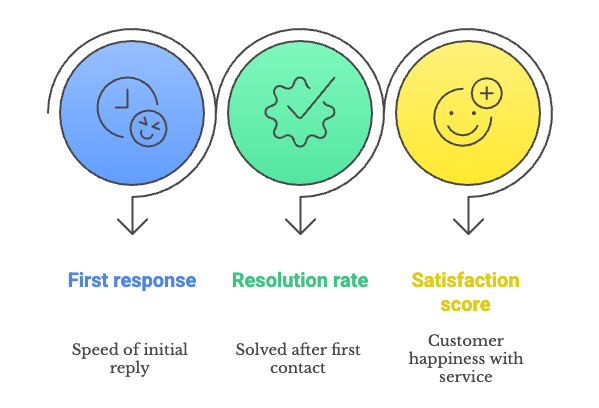
1. First response time (FRT)
How fast are you getting back to customers? The industry average is over 12 hours, but most customers want replies in less than four. Beat that, and you’ll stand out.
2. Resolution rate / First contact resolution (FCR)
How often do you solve a problem on the first try? Aiming for around 70–79% is good, but 80%+ is world-class. Plus, better FCR means happier customers.
3. Customer satisfaction score (CSAT)
After every interaction, ask your customers how you did. Scores around 75–85% are solid; hitting 90%+ means you’re doing a fantastic job.
Use dashboards from your platform to keep these numbers front and center — knowing where you stand helps you get better.
Use your data to actually improve
KPIs aren’t just for showing off — they’re your roadmap to better service.
- Set clear goals like “cut live chat response times by 30 seconds this month”
- Use low scores to figure out what needs training or tweaking
- Pay attention to what customers say in their own words — that’s gold
Help your team help your customers
Great startup customer service doesn’t happen by accident. Your team needs support, too:
- Set clear goals everyone understands
- Define who does what, so nobody’s stepping on toes
- Start with the basics — a dedicated support email and simple ticket system — then add live chat, knowledge bases, and automation as you grow
- Celebrate the wins! Shout-outs, bonuses, or even small surprises go a long way
What does customer service talent cost?
Good support folks aren’t free — but they’re worth it. On average, startup support roles pay around $57,000 a year, though it varies by city and experience. Investing here means your customers get the care they deserve.
The bottom line: the startup that supports best, wins
Lots of startups obsess over product features — but forget about great customer service. Don’t be that startup.
Building standout startup customer service is about:
- Training your team to listen and really understand
- Using a smart, growing customer service platform
- Tracking the handful of metrics that matter
- Giving your team the tools and recognition they need
When your customers feel truly cared for, they don’t just stick around — they tell their friends, become loyal fans, and help your startup grow.
What most founders get wrong about startup customer service (and how to fix it)
Customer service isn't just an afterthought for startups—it's a critical growth lever. While 96% of consumers say great service creates brand loyalty, many founders neglect this area, focusing solely on product development and fundraising.
- Common mistakes: No clear support process, undertrained agents, and ignoring valuable customer feedback
- Team training: Focus on empathy-first support with ongoing training and real-world scenarios
- Essential systems: Implement a dedicated customer service platform that centralizes communications and scales with your growth
- Critical KPIs: Track first response time, first contact resolution (aim for 80%+), and customer satisfaction scores
The startups that thrive don't just build great products—they deliver exceptional service. When customers feel genuinely cared for, they become loyal advocates who drive sustainable growth. By training your team properly, using the right support platform, and measuring what matters, you'll create a customer experience that turns one-time buyers into lifelong fans and sets your startup apart from the competition.
Frequently Asked Questions
Ideally, as soon as you start getting regular customer interactions. Even a simple ticketing system can help you stay organized and respond faster. Waiting too long often leads to missed messages, slow responses, and unhappy users who won’t come back.
At the very least, a startup needs a shared inbox, a basic ticketing system, and clear response guidelines. As you grow, consider adding live chat, automation, a knowledge base, and performance tracking tools. The goal is to make support faster, more consistent, and scalable.
It depends on your volume, but a good rule of thumb is one full-time support agent for every 150–200 support conversations per week. Early on, founders or product team members often handle support—just make sure someone "owns" it to avoid dropped balls.
In crowded markets, product features alone aren’t enough. Great customer service builds emotional loyalty. When people feel genuinely cared for, they’re more likely to stick around, forgive bugs, and tell others. It’s one of the most cost-effective growth levers a startup can use.
Startup customer service is usually leaner, scrappier, and more personal—often handled directly by founders or small teams. Enterprise support tends to be more structured, with larger teams, formal SLAs, and layered processes. Startups rely more on speed and human connection to stand out.
